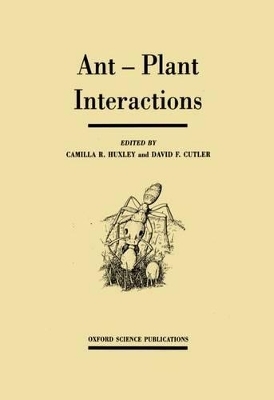
Ant-Plant Interactions
Oxford University Press (Verlag)
978-0-19-854639-9 (ISBN)
This book presents current research on all types of ant-plant interactions, and concentrates on understanding these often complex relationships in evolutionary and ecological terms. The range of interactions varies from herbivory (leaf-cutter ants) to complex symbiosis. Many ants prey on plant pests, thus protecting the plant from harm, receiving in exchange nectar and/or nest sites. In some cases the ants tend and protect other insects such as butterfly larvae or Homopterans (which include the aphids and cicadas) which may benefit the ants at the expense of both the host plant and the other insects. Some ants are known to be seed dispersers, and in at least one plant (cocoa) they appear to affect rates of pollination. A significant proportion of these interactions exhibit a high degree of mutualism, making this book part of a growing literature on the ecological determinants of mutualistic behaviour.
The thirty-seven chapters by more than fifty contributors range in geographical coverage from northern and southern temperate zones, to the New World tropics, to Australia and south-east Asia. The emphasis throughout, even in the more descriptive chapters, is on possible explanations for observed phenomena. Workers in ecology, evolution, and behaviour will welcome this compendium of information on a subject that has become a modern testing-ground for evolutionary ecology.
List of contributors; Camilla R. Huxley: Ants and plants: a diversity of interaction; Part 1: Antagonistic Interactions - The Leaf-Cutter Ants: D.J. Stradling: An introduction to the fungus-growing ants, Attini; R.J. Powell & D.J. Stradling: The selection and detoxification of plant material by fungus-growing ants; Jerome J. Howard: Resource quality and cost in the foraging of leaf-cutter ants; H.G. Fowler & Silvia Claver: Leaf-cutter ant assemblies: effects of latitude, vegetation, and behaviour; References to Part 1; Part 2: Ant-Plant Interactions Involving Herbivorous Insects: J.B. Whittaker: Effects of ants on temperate woodland trees; Rainer Rosengren & Liselotte Sundstrom: The interaction between red wood ants, Cinara aphids, and pines: a ghost of mutualism past?; J. Hall Cushman & John F. Addicott: Conditional interactions in ant-plant-herbivore mutualisms; Catherine M. Bristow: Why are so few aphids ant-tended?; S.G. Compton & H.G. Robertson: Effects of ant-homopteran systems on fig-figwasp interactions; N.E. Pierce, D.R. Nash, M. Baylis, & E.R. Carper: Variation in the attractiveness of lycaenid butterfly larvae to ants; P.J. DeVries: Evolutionary and ecological patterns in myrmecophilous riodinids; References to part 2; Part 3: Extrafloral Nectary-Mediated Interactions: Eugene W. Schupp & D.H. Feener, Jr.: Phylogeny, lifeform, and habitat dependence of ant-defended plants in a Panamanian forest; Paulo S. Oliveira & Carlos R.F. Brandao: The ant community associated with extrafloral nectaries in the Brazilian cerrados; Suzanne Koptur: Extrafloral nectaries of herbs and trees: modelling the interaction with ants and parasitoids; V.K. Rashbrook, S.G. Compton & J.H. Lawton: Bracken and ants: why is there no mutualism?; D.A. Mackay & M.A. Whalen: Some associations between ants and euphorbs in tropical Australasia; References to part 3; Part 4: Symbiosis Between Plants and Ants: Brigitte Fiala, Ulrich Maschwitz, & Tho Yow Pong: The association between Nacaranga trees and ants in South-east Asia; John T. Longino: Azteca ants in Cecropia trees: taxonomy, colony structure, and behaviour; Diane W. Davidson & Brian L. Fisher: Symbiosis of ants with Cecropia as a function of light regime; Doyle McKey: Phylogenetic analysis of the evolution of a mutualism: Leonardoxa (Caesalpiniaceae) and its associated ants; Philip S. Ward: Phylogenetic analysis of pseudomyrmecine ants associated with domatia-bearing plants; David H. Benzing: Myrmecotropy: origins, operation and importance; Matthew Jebb: Cavity structure and function in the tuberous epiphytic Rubiaceae; D.K. Letourneau: Parasitism of ant-plant mutualisms and the novel case of Piper; Pierre Jolivet: Ants, plants, and beetles; a triangular relationsip; References to part 4; Part 5: Pollination, Ant-Exclusion, and Dispersal: Rod Peakall, Steven N. Handel, & Andrew J. Beattie: The evidence for, and importance of, ant pollination; Ray Harley: The greasy pole syndrome; M. Westoby, L. Hughes, & B.L. Rice: Seed dispersal by ants: comparing infertile with fertile soils; W.J. Bond, R. Yeaton, & W.D. Stock: Myrmecocheory in Cape fynbos; Carol C. Horvitz: Light environments, stage-structure, and dispersal syndromes of Costa Rican Marantacaea; Seigo Higashhi & Fuminori Ito: Ground beetles and seed dispersal of the myrmecochorous plant Trillium tschonoskii (Liliaceae); Alan N. Andersen: Seed harvesting by ants in Australia; References to part 5; Part 6: Ants, Vegetation, and the Future of Ant-Plant Research: Stanley R.J. Woodell & Timothy J. King: The influence of mound-building ants on British lowland vegetation; John E. Tobin: A neotropical, rainforest canopy, ant community: some ecological considerations; Alan N. Andersen: Parallels between ants and plants: implications for community ecology; Andrew J. Beattie: Problems outstanding in ant-plant interaction research; Index to scientific names; Subject index.
| Erscheint lt. Verlag | 15.8.1991 |
|---|---|
| Zusatzinfo | numerous halftones, line figures, and tables |
| Verlagsort | Oxford |
| Sprache | englisch |
| Maße | 163 x 240 mm |
| Gewicht | 1094 g |
| Themenwelt | Naturwissenschaften ► Biologie ► Botanik |
| Naturwissenschaften ► Biologie ► Evolution | |
| Naturwissenschaften ► Biologie ► Ökologie / Naturschutz | |
| Naturwissenschaften ► Biologie ► Zoologie | |
| ISBN-10 | 0-19-854639-4 / 0198546394 |
| ISBN-13 | 978-0-19-854639-9 / 9780198546399 |
| Zustand | Neuware |
| Haben Sie eine Frage zum Produkt? |
aus dem Bereich


